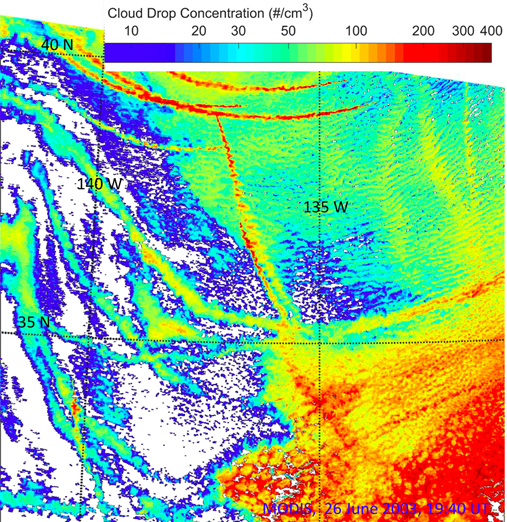博文
《Science》Global warming: Small particles have big impacts
|
A break through research carried out by scientists from Israel, China, U.S.A and German was published in Science Magazine on 17 January 2019 (Daniel Rosenfeld*#, Yannian Zhu#,
Minghuai Wang*, Youtong Zheng, Tom Goren, and Shaocai Yu*, 2019.
Aerosol-driven droplet concentrations dominate coverage and water of
oceanic low level clouds, Science, 17 January 2019, Vol 363, Issue 6424. http://science.sciencemag.org/content/early/2019/01/16/science.aav0566?rss=1). The research elucidates the effects of air pollution on global warming
Global warming may lead to climatic changes that will affect directly the ways that we will live on Earth. The scientific consensus determines that global warming is caused by manmade emissions of greenhouse gases, and that a transition to renewable energy is required to mitigate these effects. However, there is a large uncertainty in the quantification of the predicted amount of warming until the end of the 21st century, which varies between 1.5 and 4.5 degrees of warming, while each additional degree brings greater risks.
A new research, led by Prof Daniel Rosenfeld (first and corresponding author, The Hebrew University of Jerusalem), including Dr. Yannian Zhu (equal first author, Meteorological Institute of Shaanxi Province), Prof. Minghuai Wang (corresponding author, Nanjing University), Dr. Youtong Zheng (University of Maryland-College Park), Dr. Tom Goren (University of Leipzig), Prof. Shaocai Yu (corresponding author, Zhejiang University), addresses the ways by which particulate air pollution works to cool Earth and offset part of the warming induced by the emitted greenhouse gases. The research shows that the extent by which the aerosols cool the climate system via their effects on clouds is much greater than previously estimated. Aerosols are tiny particles that float in the air. They can form naturally (e.g., desert dust) and artificially (e.g., smoke from burning of fuel). A cloud is formed when air rises and cools, and water vapor is condensed on the aerosol particles and forms the cloud droplets. The clouds are formed primarily by the meteorological causes that induce air to rise and cool, but the clouds composition is largely determined by the aerosols. A cloud that is formed in air that contains large number of aerosol particles is composed of larger number of smaller droplets, which require longer time for coalesce into rain drops that precipitate from the cloud. Therefore, polluted clouds contain more water, live longer and cover larger area, thus reflecting more solar energy back to space.
Until this research it was not possible to measure the aerosol effects on clouds with sufficient accuracy, because it was impossible to separate the effects of the vertical rising winds that build the clouds and the effects of aerosols that determine the clouds composition. This was made possible by the methodology that was developed by Prof' Rosenfeld and his research partners, which is a satellite based methodology for simultaneous measurements of the vertical wind at cloud base and cloud composition. The application of this methodology to low clouds over ocean showed that the aerosols induce a significant increase of cloud water content and cloud area coverage, much beyond the present estimates, and respectively have a much greater cooling effect than previously believed.
The research team believes that if the aerosols indeed cause a greater cooling than previous estimates, then the warming effect of the greenhouse gases should be also larger than previous estimates to be able to overcome that cooling and bring to the amount of global warming that has already occurred. This implies greater future warming than previous estimates, because the greenhouse gases cumulate in the atmosphere, while the aerosol concentrations do not increase, and may even decrease with the development of cleaner combustion which emit less aerosols, but the same amount of greenhouse gases. The research team offers a more likely but yet unexplored alternative possibility that explains the present global warming is offsetting of the aerosols cooling effects on low clouds by another possible warming effect of aerosols by their impacts on deep and high clouds, which has not yet been discovered.
Either way, the conclusion is the same. The present calculations of global climate predictions do not take into account correctly the large effects of aerosols on clouds and the resultant impacts on Earth's energy budget. Initially it leads to the realization that the present uncertainty with respect to the predicted global warming is greater than the range of 1.5 to 4.5 degrees until the end of the century. However, implementation of the methodologies developed by Prof' Rosenfeld and his team will allow measurements and calculations that will lead to more accurate climate predictions.

Fig 1. A satellite image of shallow clouds in the Pacific Ocean to the west of the USA. The colors show the cloud drop number concentrations in cubic cm. The tracks of polluted clouds from the ship emissions are evident by the elevated droplet concentrations. A concentration larger than 50 drops per cubic cm suppresses the precipitation which breaks up the cloud cover. It is evident that clouds with large drop concentrations are affected by a criss-cross of old ship tracks, which induce a large cloud cover that reflects much solar radiation back to space.
https://blog.sciencenet.cn/blog-1220241-1157788.html
上一篇:北京达严重污染:11月23日至26日京津冀及周边
下一篇:局部水雾地球工程方法应用案例:降温又减轻大气臭氧污染